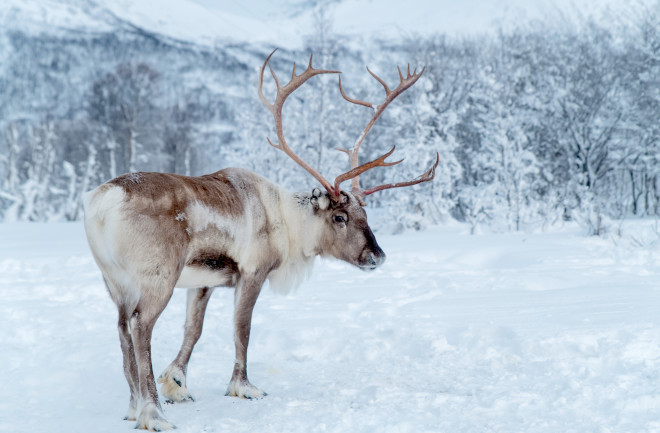"He sprang to his sleigh, to his team gave a whistle. And away they all flew like the down of a thistle."
Flying reindeer have long been synonymous with Christmas. In 1823, they were described pulling Santa's sleigh in the now-infamous poem, “A Visit from St. Nicholas,” more commonly known as “’Twas the Night Before Christmas.” Indeed, modern tales of flying reindeer may even stretch back to Norse mythology, inspired by legends of Thor, the god of thunder who soared through the sky in a chariot pulled by magical goats.
Still, scientifically speaking, there are no known species of reindeer that can fly. (Bats are the only type of mammal capable of true flight.) But what does physics say about the plausibility of flying reindeer?
The Physics of Flying Reindeer
Reindeer, like anything else, can technically fly. But actually achieving liftoff would require a lot more energy than the animals typically have available.
Overcoming Gravity and Drag
If we’re going to talk about flight, we need to talk about forces first. Any flying object, from a bee to a bird to a plane, has two major forces conspiring against it. The first is gravity, which is always pulling the object — in our case, a reindeer — to the ground. If you want to fly, then you need some way of counteracting that gravitational pull.
The other force is drag. Every flying object is actually moving through an ocean of air molecules. And even though air itself isn’t all that dense, it takes a lot of work to reach the speed needed to sustain flight. Drag saps energy out of the flying object, which will cause it to lose speed and drop to the ground.
Living creatures and human engineers alike have devised innumerable ways to overcome these two negative forces, but no matter the solution, the trick comes down to generating two forces to compete against them, called lift and thrust.
Generating Lift and Thrust
Thrust is a simple forward movement through the air to counteract the force of drag. Whether it's a bird’s flapping wing or the exhaust of a jet engine, most flying objects use air to generate thrust by pushing air behind the object. Through conservation of momentum, there is an equal and opposite force that propels the object forward (much like in swimming, where you push water behind you to get yourself to move forward).
Meanwhile, lift is the force required to counteract gravity, and so it points directly up. Airplanes generate lift by having wings with curved surfaces. As the air slips over the wing, some of that air is pushed downwards.
Again, by conservation of momentum, this lifts the airplane up. It might seem counterintuitive (and perhaps just as magical as Santa's sleigh), but essentially, airplanes press downwards on air to go higher the same way you press downwards on the floor to stand up.
Read More: The Origins of Flight, From Birds to Bugs to Planes
Why Can't Reindeer Fly?
Unfortunately for reindeer, they have no efficient way to generate lift or thrust. Wild reindeer have been recorded achieving top speeds of 50 miles per hour. This is roughly the same flying speed of the great California Condor and far faster than the flying speed of a common backyard bird like a sparrow.
When it comes to flight, however, this kind of thrust wouldn't be very useful to a reindeer, since to achieve that speed, the animal must push against the ground. Once it reaches into the air, the reindeer is no longer capable of generating thrust.
Even if they could create thrust in midair, reindeer also don’t have any easy way to generate lift. And they need quite a bit of lift: An adult female reindeer will weigh somewhere between 180 to 260 pounds, while males tip the scales at about 350 to 400 pounds, all packed into a frame about 6 feet long from snout to tail.
Compare that to an Andean condor, the largest bird of prey in the world. An Andean condor has a wingspan of over 10 feet across but weighs only around 33 pounds — less than a tenth of a male reindeer. This means that the condor doesn’t have to generate nearly as much lift as a reindeer would.
The condor’s complex arrangement of skeleton, wings, and feathers allows it to stay aloft for hours at a time, as well as land and take off with relative ease. Even if a reindeer could somehow achieve the velocities necessary to maintain thrust, it has no wings, so it can’t generate any lift.
Read More: When Do Deer Shed Their Antlers? And 6 Other Antler Questions
Could Humans Ever Help Reindeer Achieve Flight?
The only option for a flight-ready reindeer would be to make drastic modifications. We would need to add a source of artificial acceleration, like an outboard jet engine. Modern jet engines can achieve incredible amounts of thrust, handily pushing the mass of the reindeer forward.
Still, such a contraption would also need lift, and so we would have to add wings to the side of the reindeer. It would also need fuel — let's assume that a reindeer’s typical diet would not provide the energy necessary to power a jet engine — and electronics to allow for control of the wing surfaces. We would also need a tail and rudder for stabilization.
But all these additions bring their own weight, so we would have to scale the reindeer attachments appropriately, giving it a large enough engine and a big enough wing to keep it in flight. Essentially, the easiest way to get a reindeer to fly would be to stick it inside an airplane.
Still, it should be noted that this analysis has centered around typical reindeer. Santa’s reindeer obviously work on different, non-physics-based principles and requires an entirely separate discussion.
Read More: Why Some Can’t Get Enough Of Hallmark Christmas Movies

